Over the past 17 years, Afghanistan’s international donors have poured nearly US$1 billion into the country’s elections. Given the legacy of violence and lost opportunities, it’s time these donors pushed Afghan authorities to make sure these elections have a better chance of delivering on the promise of democratic rule for the Afghan people.
On October 20, Afghans will go to the polls for parliamentary elections that were meant to be held in 2015. Rising insecurity and contested electoral reforms delayed the vote, and both still threaten the outcome. Since June, 10 parliamentary candidates have been killed in suicide bombings and other attacks. The Taliban claimed responsibility for an October 17 bombing that killed candidate Jabar Qahraman in Helmand, a province insurgents largely control, and for the September 25 killing of candidate Nasir Mubarez in Kandahar. The Islamic State of Khorasan Province (ISKP), an affiliate of the Islamic State (also known as ISIS), has claimed responsibility for multiple attacks, particularly in Nangarhar province, including a July 1 bombing that killed Sikh candidate Avtar Singh Khalsa.
Many more Afghans have been injured or killed in attacks on voter registration centers, campaign rallies, and other election related activities. From January through September, the United Nations Assistance Mission for Afghanistan documented 126 deaths and 240 injuries among civilians in election-related violence. The Afghanistan Independent Human Rights Commission has raised concerns about more attacks on voters on election day, as the Taliban have called on Afghans to boycott the vote.
Violence is not the only concern. Despite promised electoral reforms, problems that have plagued past elections have multiplied, and include suspicious voter registration numbers, fake ID cards, scores of polling centers closed because of security or, in one case, political deadlock over defining constituencies. Contested results, which are almost inevitable, may lead to even greater instability and provoke a political crisis.
But despite all this, there is reason for hope. More Afghan women are running for office than ever before, some of whom have campaigned on advancing women’s rights and girls’ education. Others have campaigned against corruption and Afghanistan’s entrenched “warlord” political elite. All candidates have assumed tremendous risks, as do voters who will turn out on election day.
Donors, who have long welcomed elections in Afghanistan but too often turned a blind eye to electoral fraud, need to help ensure it’s a risk worth taking.








